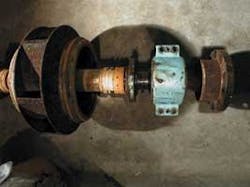Forensic analysis of the other Type 1 Seal on the double-ended vertical pump shaft still exhibited functional working parameters. Sealing surfaces are still intact aided by adequate flush support.
Click here to enlarge imageIn April 1963, engineers at the Kenosha Water Utility in Kenosha, Wisconsin, on Lake Michigan installed two Delaval Type 100 M vertical pumps fitted with John Crane Type 1 mechanical seals on the facility's north and south backwash pumps.
In April 2003, plant operators in the Kenosha Water Utility discovered a leak in the north backwash pump caused by a clogged flush line - ending a 40-year lifespan of John Crane's first patented mechanical seal - a service that endured an estimated two billion gallons of treated water. The municipal Kenosha Water Utility provides water and wastewater service to more than 100,000 people.
More remarkable is that plant personnel inspected the sister seals on the south backwash pump, also installed in 1963, and found them to be in good condition - 40 years on the job and still running as it did when first installed. Mechanical seals
manufactured by John Crane are known for their longevity, but company officials admit that 40 years of service is an aberration.
"I knew the seals hadn't been changed during my 15 years at the plant, but I assumed that the seals had been replaced sometime during their 40-year life," said David Lewis, Kenosha's water production superintendent.
However, a follow-up with previous superintendents and John Crane personnel confirmed that the seals were indeed the original equipment - Type 1 mechanical seals three-inches in diameter with flexible rubber bellows, lapped carbon seal face and ni-resist mating ring. Their retainer, disc, drive band, spring and spring holder were all constructed of brass, and during operating conditions, the seals ran in clean water at ambient temperature at 1,175 rpm. The seals had been installed on vertical pumps used to pull water from the Kenosha plant's finished water clearwell and pump it into a 250,000-gallon backwash tank while supplying pressure to assist in backwashing the plant's sand filters.
During the systematic analysis of the application and diagnosis of the failure, John Crane engineers and Kenosha plant operators discovered that the north pump's flush line had stopped working. Minerals from the water of Lake Michigan had built up over the years, causing a blockage in the line. Without the water from the flush line to cool the seal, the rubber bellows, carbon seal face and ni-resist mating ring became overheated. The result was melting and disintegration of the rubber bellows portion of the seal and astonishing proof that the malfunction of the flush line caused the Type 1 seal's failure, not the seal. Further, an inspection showed the original Type 1 seal on south backwash pump to be in good condition.
The typical life expectancy for a mechanical seal of this type balances a variety of factors, including the operating conditions and environment, although three to five years is a reasonable industry estimate. However, Kraus said he knows of seals that ran for 20 years and does not believe the seals found at the Kenosha Water Utility are an isolated case.
"The superb condition of the seal faces and other critical components indicate that this seal would still be in service today if the flush line would not have become clogged," said Kraus.
The flush line on the south backwash pump was replaced to prevent a similar incident from occurring in the future and a new Type 1 seal was installed on the north backwash pump. Interestingly, with the exception of using stainless steel components instead of brass, the new and old seals are virtually the same, validating the effectiveness of the original design.
Mechanical seals serve the basic yet important function of preventing leakage by closing a gap or making a joint between two surfaces that have relative motion. In a pump, the shaft moves in relation to the housing unit, requiring a device such as a mechanical seal to dynamically fill the void between those two surfaces. In order to prevent any liquid leakage under demanding conditions, the dynamic sealing interface of a new seal is lapped flat within millionths of an inch
Author's Note
Mike Krause is the market manager of John Crane, based in Morton Grove, Illinois, USA. For more information, visit the website: www.johncrane.com or contact the author by email: [email protected].


